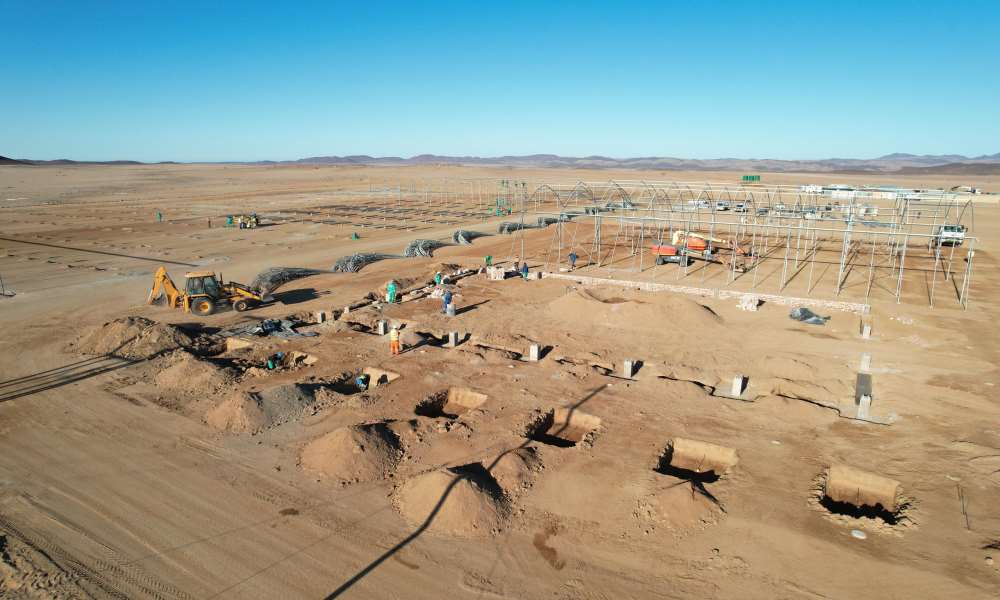In The Press, News
Daures’ Green Tomato Harvest Reserved for Local Consumption
Fresh produce to be harvested from the Daures Green Hydrogen Village (DGHV) project will all be consumed locally.
This was announced by Jerome Namaseb, CEO of the Daures Green Hydrogen Village during the ongoing Green Hydrogen Symposium in Windhoek.
Namaseb said they expect to harvest about 400 tonnes of tomatoes this season.
Located near Uis in the Erongo area, the project serves as a research and proof-of-concept facility for Namibia’s green hydrogen and green ammonia economies.
Namaseb disclosed this information during an interview with Eagle FM, emphasising the project’s commitment to local utilisation of its agricultural produce.
Namaseb highlighted that the green hydrogen village, in its trial phase, aims to produce up to 100 tonnes of green ammonia and over 400 tonnes of green tomatoes annually, contributing significantly to local agricultural production.
Utilising greenhouse structures, the project ensures optimal conditions for tomato growth, addressing Namibia’s dependency on tomato imports.
Namaseb affirmed that the village’s greenhouse technology enables the cultivation of various vegetables, providing sustainable solutions to domestic food production challenges.
Namibia’s reliance on tomato imports underscores the significance of this initiative. In 2023, the nation produced 1,844 tonnes of tomatoes for formal marketing, with substantial imports to meet local demand.
Negotiations with tomato offtakers have already commenced, signifying the project’s proactive approach towards local market integration.
Namaseb highlighted ongoing discussions with various stakeholders to facilitate the offtake of tomatoes produced by the project.
Echoing Namaseb’s remarks, Obeth Kandjoze, Chairman of the Green Hydrogen Council, announced during the symposium that the project is 80% complete and is poised to commence ammonia and green hydrogen production by July 2024.
Namaseb reiterated the project’s progress, indicating that construction is nearing completion, with ammonia synthesis units and electrolysers expected to be operational by April or early May. Commissioning, testing, and training will follow, with plans to launch the facility by the end of July 2024.
By July, the community aims to produce approximately 100 tonnes of green ammonia, with initial collaborations established with local businesses to utilise the product.
Namaseb emphasised the project’s role as a proof of concept for green hydrogen and green ammonia production, setting the stage for sustainable development in Namibia’s energy and agricultural sectors.
With funding totaling N$220 million from the German Federal Ministry of Education and Research (BMBF), the DGHV project is poised to spearhead Namibia’s production of green ammonia and green hydrogen.
Regarding the initiative’s impact, Kandjoze noted that as of November 2023, over 200 Namibians were employed by more than thirty small and medium-sized enterprises (SMEs), primarily located in nearby settlements.
He emphasised that over 80% of the population in the Daures Constituency earns less than $1 per day, highlighting the imperative need for green job creation in the region.
Furthermore, Kandjoze revealed that the World Food Programme (WFP) and AgriBusdev have expressed interest in procuring locally manufactured green fertiliser.
The DGHV project has completed research to develop green ammonia sulphate fertiliser, showcasing its potential to contribute to agricultural sustainability.
In terms of future projections, Kandjoze highlighted the promising outlook for the Daures project, suggesting that by 2030, the village could produce and export up to 700,000 tonnes of green ammonia during its fourth phase.
He emphasised that these projections indicate competitiveness on a global scale, with the potential to account for approximately 30% of the Hyphen project’s magnitude in South Namibia.

